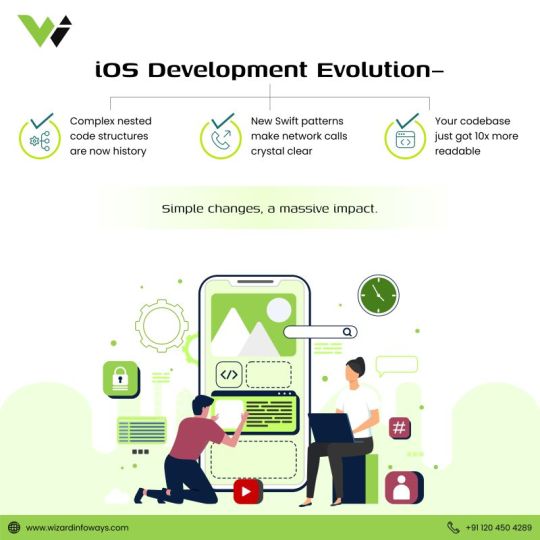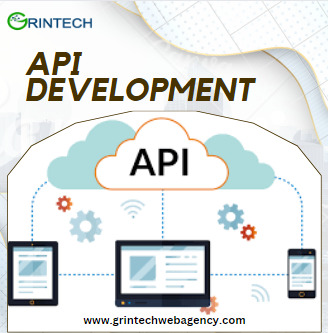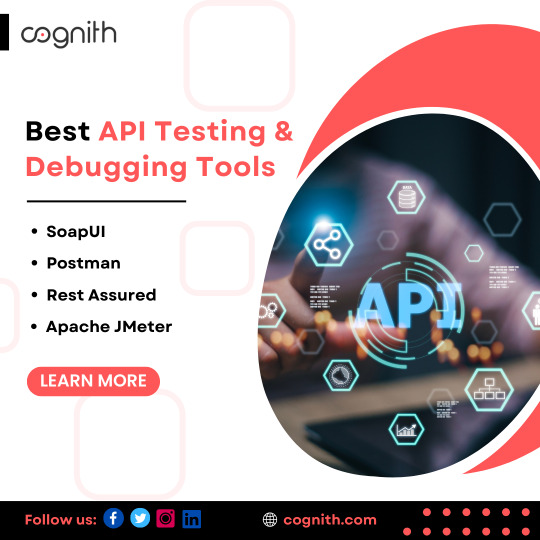#application programming interfaces
Explore tagged Tumblr posts
Text
API development is a cornerstone for contemporary applications in today’s hyper-related virtual world. APIs (Application Programming Interfaces) empower developers to integrate various systems and create seamless and enriched experiences, making them indispensable in app development.
This article illuminates you on why APIs matter and how businesses can leverage them for success.
So, what’re you waiting for? Let’s delve deep into the world of API development.
Happy reading!
#api development#Application Programming Interfaces#apis#app development#mobile app development#software development process
0 notes
Text

Clean code isn't just about fewer lines - it's about telling a clearer story. Here's why iOS development is getting better. Read More...
#ios app development#application development service#ios app developers#application programming interfaces#web application development#wizardinfoways
0 notes
Text
API-First Development: Revolutionizing Digital Integration and Scalability

Explore how API-first development is transforming digital integration and scalability. Learn how this approach streamlines development, enhances flexibility, and enables seamless communication between systems, driving innovation and growth in modern applications. Visit now to read more: API-First Development: Revolutionizing Digital Integration and Scalability
#agile development#api management#api strategy#api-first development#application programming interfaces#digital integration#digital transformation#microservices architecture#reusable apis#scalable software#software delivery velocity
0 notes
Text
Understanding the Basics of APIs
Application Programming Interfaces (APIs)
crucial components in modern software development. They allow different software systems to communicate with each other and facilitate the integration of various services and functionalities. This article explores the basics of APIs, their types, and their importance in today’s tech landscape.

What is an API? for more........
An API (Application Programming Interface) is a set of rules and protocols that allows one piece of software to interact with another. It defines the methods and data formats that applications can use to request and exchange information. APIs enable different software systems to communicate, share data, and perform operations without needing to understand each other's underlying code.
Key Concepts:
Endpoint: A specific URL where an API service can be accessed. Endpoints represent different functionalities or resources offered by the API.
Request: The action taken by a client to interact with an API, such as retrieving data or sending information. Requests typically include a method (GET, POST, PUT, DELETE), headers, and sometimes a body.
Response: The data or acknowledgment returned by the API after processing a request. Responses usually include status codes, headers, and a body containing the requested information or result.
Authentication: A process used to verify the identity of a user or application accessing the API. Common methods include API keys, OAuth tokens, and Basic Auth.
Types of APIs
Web APIs: Also known as HTTP APIs or REST APIs, these are accessed over the web using HTTP/HTTPS protocols. They are widely used for web services and allow different systems to communicate via the internet.
RESTful APIs: Representational State Transfer (REST) APIs use standard HTTP methods and are designed to be stateless. They operate on resources identified by URLs and support various formats like JSON and XML.
SOAP APIs: Simple Object Access Protocol (SOAP) APIs use XML-based messaging protocols for exchanging information. SOAP APIs are known for their robustness and are often used in enterprise environments.
GraphQL APIs: A query language for APIs that allows clients to request specific data. GraphQL APIs provide a more flexible and efficient way to interact with data compared to REST APIs.
Library APIs: These APIs are part of software libraries or frameworks that provide predefined methods and functionalities for developers to use in their applications.

Click now
For those interested in deepening their understanding of APIs, including practical applications and advanced concepts, Getege offers a comprehensive course. This course provides detailed insights into API design, implementation, and best practices, helping you master the fundamentals and more complex aspects of API development.
#APIs#Application Programming Interfaces#REST API#SOAP API#GraphQL API#Web APIs#API Basics#API Integration
0 notes
Text
In the realm of mobile app development, APIs (Application Programming Interfaces) are akin to secret tunnels that allow different software programs to communicate effortlessly.
#mobile app development#API in mobile app development#Application Programming Interfaces#advantage of using API in mobile app
0 notes
Text
What is API Development : A Cutting-Edge API Development Unveils Seamless Integration Solutions For Websites
API stands for Application Programming Interface. In the context of APIs, the word Application refers to any software with a distinct function. API development refers to the process of creating Application Programming Interfaces (APIs), which are sets of rules and protocols that allow different software applications to communicate with each other.

APIs define the methods and data formats that applications can use to request and exchange information. They enable developers to build software that can interact with other systems, access external data or services, and integrate with various platforms. API development involves designing, building, testing, documenting, and maintaining APIs to ensure smooth and efficient communication between different software components or systems.
#API Development#Application Programming Interfaces#Web Development#what is web agency#grintech web agency#best web agency#web design and web development agency#API Development Agency
0 notes
Text
Application Programming Interfaces
Abhishek Jain, a seasoned expert in Application Programming Interfaces (APIs), offers profound insights and expertise in optimizing software integration. With a wealth of experience, he navigates the intricacies of APIs, empowering developers and businesses to harness the full potential of seamless and efficient application connectivity
0 notes
Text
Oracle Transforms Care Delivery With Next-Generation Millennium EHR And Generative AI Capabilities

Developers will be able to access these APIs and related documentation within their existing Oracle Health console. This accessibility empowers developers to test these APIs in a public sandbox, slated for release later this year. These new APIs complement the existing set of 165+ standards-based public APIs that use the Fast Healthcare Interoperability Resources (FHIR).
Read More - https://www.techdogs.com/tech-news/pr-newswire/oracle-transforms-care-delivery-with-next-generation-millennium-ehr-and-generative-ai-capabilities
0 notes
Text
What Is Object-Oriented Programming in Java and Why Does It Matter?

Java is super popular in the programming world, and one of the main reasons for that is its use of object-oriented programming (OOP). So, what exactly is OOP in Java, and why should you care? OOP is a way to organize your code by grouping related data and functions into objects. This makes Java easier to work with, more organized, and simpler to update.
Key Ideas Behind Object-Oriented Programming
To get a grip on OOP in Java, you need to know four main ideas: Encapsulation, Inheritance, Polymorphism, and Abstraction. These concepts help you write clean and reusable code, which is pretty important in software development today.
Encapsulation: Keeping Data Safe
Encapsulation means protecting the internal data of an object from being accessed directly. You do this using private variables and public methods. When you take a Java course in Coimbatore, you’ll learn how this helps keep your code secure and safeguards data from accidental changes.
Inheritance: Building on Existing Code
Inheritance lets a new class take on the properties of an existing class, which cuts down on code repetition and encourages reuse. Grasping this idea is key if you want to dive deeper into Java development, especially in a Java Full Stack Developer course in Coimbatore.
Polymorphism: Flexibility in Code
Polymorphism allows you to treat objects as if they are from their parent class rather than their specific class. This means you can write more flexible code that works across different cases. You’ll definitely encounter this in Java training in Coimbatore, and it’s essential for creating scalable applications.
Abstraction: Simplifying Complexity
Abstraction is all about hiding the messy details and only showing what’s necessary. For example, when you use your smartphone, you don’t need to understand how everything works inside it. Java uses abstract classes and interfaces to make things simpler, which you’ll notice in any solid Java course in Coimbatore.
Why It Matters in Real Life
So, circling back: What is OOP in Java and why is it important? Its real strength comes from making big software projects easier to manage. OOP allows multiple developers to work on their parts without stepping on each other’s toes.
OOP and Full Stack Development
Full stack developers cover both the frontend and backend. Understanding OOP in Java can make your backend logic much better. That’s why a Java Full Stack Developer Course in Coimbatore focuses on OOP right from the start.
Java and Your Career Path
If you're looking to become a software developer, getting a good handle on OOP is a must. Companies love using Java for building big applications because of its OOP focus. Joining a Java training program in Coimbatore can help you get the practical experience you need to be job-ready.
Wrapping Up: Start Your Java Journey with Xplore IT Corp
So, what is object-oriented programming in Java and why is it important? It’s a great way to create secure and reusable applications. Whether you’re interested in a Java Course in Coimbatore, a Full Stack Developer course, or overall Java training, Xplore IT Corp has programs to help you kick off your career.
FAQs
1. What are the main ideas of OOP in Java?
The key ideas are Encapsulation, Inheritance, Polymorphism, and Abstraction.
2. Why should I learn OOP in Java?
Because it’s the foundation of Java and helps you create modular and efficient code.
3. Is it tough to learn OOP for beginners?
Not really! With good guidance from a quality Java training program in Coimbatore, it becomes easy and fun.
4. Do I need to know OOP for full stack development?
Definitely! Most backend work in full stack development is based on OOP, which is covered in a Java Full Stack Developer Course in Coimbatore.
5. Where can I find good Java courses in Coimbatore?
You should check out Xplore IT Corp; they’re known for offering the best Java courses around.
#Java programming#object-oriented concepts#Java syntax#Java classes#Java objects#Java methods#Java interface#Java inheritance#Java encapsulation#Java abstraction#Java polymorphism#Java virtual machine#Java development tools#Java backend development#Java software development#Java programming basics#advanced Java programming#Java application development#Java code examples#Java programming logic
0 notes
Text
Software Development Market Anticipated to Grow Owing to Digital Transformation
The Software Development Market offers a spectrum of solutions ranging from custom application development and enterprise resource planning (ERP) software to mobile apps, cloud-native platforms, and DevOps toolchains. These products streamline workflows, automate business processes, and enable real-time analytics, driving operational efficiency and improving time-to-market. Organizations leverage these solutions to enhance customer engagement, scale infrastructure dynamically, and reduce total cost of ownership.
Get More Insights on Software Development Market https://www.patreon.com/posts/software-market-131141770

#SoftwareDevelopmentMarket#AIdrivenAutomation#IDEs (for Integrated Development Environments)#APIs (for Application Programming Interfaces)#CoherentMarketInsights
0 notes
Text
How App Interface Design Is Evolving with AI and User-Centric UX Trends

App Interface Design's Evolution: AI and User-Centric UX Trends Consider this: The average smartphone user touches their device over 2,600 times a day. For heavy users, that figure soars past 5,400. Each tap, swipe, and pinch interacts directly with an interface designed to guide them. But are those interfaces truly serving users in 2025, amidst accelerating technological user-centric UX trends and the pervasive influence of AI in design? The traditional ways we conceived of and built interfaces are rapidly transforming, driven by sophisticated algorithms and a renewed, imperative focus on authentic user-centric design.
The AI Paradigm Shift in Interface Creation
Artificial intelligence isn't merely a tool add-on; it signifies a profound paradigm shift in how we approach the very foundations of app interface design. Overtly, AI automates routine tasks. Subtly, it augments creativity, analyzes colossal datasets with unprecedented alacrity, and stands poised to recalibrate the designer's role entirely. This isn't science fiction anymore; it's the operating reality for forward-thinking design teams.
AI Assisting Design Workflows
Integrating AI assistance into workflows offers tangible improvements in efficiency and opens avenues for novel design possibilities.
Automation of Repetitive Tasks: Tedious activities such as image slicing, code generation for basic components, or initial layout variations can be handled by AI. This frees designers to concentrate on more complex problem-solving, creative conceptualization, and strategic thinking. Think of AI not as replacement, but as a highly efficient junior assistant handling the groundwork.
Generating Design Variations: Based on established brand guidelines, user data, or even initial wireframes, AI algorithms can generate a myriad of design options in moments. This velocity allows for rapid iteration and comparative analysis, potentially unveiling design directions a human might not have considered within the same timeframe.
Predictive Analytics for User Behavior: AI's capacity to sift through vast quantities of usage data identifies patterns and predicts user actions with increasing accuracy. This predictive power directly informs design decisions, allowing interfaces to pre-empt user needs or present information most relevant to an individual's predicted journey within the application.
Ethical Considerations and Bias Mitigation
As AI becomes more entrenched in the design process, acknowledging and actively mitigating inherent biases is absolutely paramount. AI models are trained on data, and if that data reflects societal biases (racial, gender, ability, etc.), the AI will perpetuate them in its design outputs.
Vigilance is required to audit the data sources used for AI training.
Testing AI-generated designs across diverse user demographics is crucial to identify and rectify unfair or exclusionary outcomes.
Maintaining human oversight in crucial decision points of the design process safeguards against automated discrimination or ethically questionable design patterns. Designers become stewards, ensuring the AI serves human well-being and inclusivity.
The Core of User-Centricity in 2025
While technology sprints ahead, the raison d'être of design remains constant: serving the user. User-centric UX trends are less about adopting flashy tech and more about a deeply empathetic approach that prioritizes genuine human needs, contexts, and emotions. In 2025, "user-centric" holds a more nuanced, sophisticated meaning than ever before.
Understanding Evolving User Needs
User expectations aren't static; they morph with technological fluency and societal shifts. A truly user-centric design understands this fluidity.
Hyper-Personalization: Beyond simply using a user's name, personalization now demands interfaces that adapt content, features, and even visual style based on real-time context, historical usage, preferences, and predicted needs. This requires a granular understanding of individual users, facilitated by AI analysis.
Accessibility as a Universal Standard: Designing for accessibility is no longer an afterthought or an optional feature; it is a fundamental requirement. This encompasses not only compliance with guidelines (like WCAG) but designing intuitively for users with diverse cognitive, visual, auditory, and motor abilities from the outset. Inaccessible design effectively excludes large potential user bases.
Emotional Design (Kansei UX): Moving beyond usability, designers now consider the emotional resonance of an interface. Does it feel joyful, trustworthy, calming, exciting? Kansei engineering, originating in Japan, studies how users feel about products. Applying these principles to app interface design fosters deeper user engagement and loyalty by consciously eliciting positive emotional responses.
Measuring and Iterating on User Experience
Good design isn't guesswork; it's an iterative process informed by data and direct user feedback. Measuring the efficacy of designs is foundational to refinement.
Employing robust analytics to track user flows, completion rates, points of friction, and feature engagement.
Conducting diverse forms of user research: usability testing, interviews, surveys, and contextual inquiries.
Utilizing A/B testing and multivariate testing to compare design variations head-to-head based on quantifiable user behavior metrics.
Establishing continuous feedback loops, allowing designers to remain responsive to evolving user sentiments and needs over the product lifecycle.
Synergizing AI and User-Centric Approaches
The true power emerges not from choosing between AI-driven or user-centric design, but by strategically intertwining them. AI, when wielded through a user-centric lens, can elevate interfaces to new heights of relevance, adaptability, and intuitiveness. Conversely, user-centric design principles provide the ethical and humanistic framework that prevents AI from creating sterile, unhelpful, or biased interfaces. This confluence marks the frontier of advanced app interface design.
Designing Adaptive Interfaces
Adaptive interfaces change dynamically based on individual users, their context, and even their momentary state. AI is the engine that makes this feasible on a large scale.
Real-time Customization via AI: Imagine an interface that changes button size for a user walking in bright sunlight, or adjusts complexity for a novice versus an expert user within the same application. AI processes data streams (device sensors, usage history, explicit preferences) to make these interface adjustments happen in the moment.
Contextual Awareness: An interface that knows you're driving might simplify controls; one that knows you're in a quiet library might suggest different features. AI enables applications to understand and react to the user's current environmental and situational context, presenting information and interactions most appropriate to that specific scenario.
Leveraging AI for Deeper User Insights
AI's analytical capabilities allow us to move beyond simple clickstream data to glean profound insights into user motivations, difficulties, and implicit desires.
Beyond Basic Analytics: Instead of just seeing where users click, AI can help understand why they might be hesitating at a certain point, what task they are likely attempting based on partial actions, or how their usage patterns compare to others with similar profiles.
Identifying Implicit Needs: Users often struggle to articulate exactly what they need or want. AI can analyze vast datasets – including user support interactions, social media sentiment, and aggregate usage patterns – to uncover latent needs or points of frustration that users themselves haven't explicitly mentioned.
Building Trust in AI-Powered UX
As AI's role becomes more overt (e.g., a chatbot, a recommendation engine, an interface that visibly rearranges itself), building and maintaining user trust becomes critical.
Transparency in AI Decisions: Users appreciate knowing why something is being recommended, why the interface changed, or why certain options are presented. Explaining the basis of an AI-driven interaction fosters confidence. Avoid 'black box' scenarios where the AI's actions seem arbitrary.
Maintaining Human Oversight: For critical decisions or sensitive interactions, the system should allow for human intervention or fallback options. Users need assurance that they aren't solely at the mercy of an algorithm and can access human support if needed. This hybrid approach leverages AI's strengths while providing a safety net and building trust.
Practical Guide: Navigating the Evolution
Making this transition isn't automatic. It requires a deliberate approach to strategy, a willingness to adapt, and a proactive stance against common pitfalls. Think of this section as laying out actionable considerations for design teams in 2025.
Strategies for Adoption
Successfully integrating AI in design and doubling down on user-centric design demands a multifaceted strategy.
Education and Upskilling: Design teams require new literacies. Understanding basic AI concepts, data interpretation, ethical AI principles, and advanced research methodologies are no longer niche skills; they are becoming foundational. Organizations must invest in continuous learning.
Iterative AI Integration: Do not attempt a monolithic overhaul. Begin by integrating AI into specific, well-defined areas of the design workflow or user experience where its value is clearest (e.g., content personalization, component generation, preliminary usability analysis). Learn from these early efforts and expand incrementally.
Collaboration (Designers, Data Scientists, Users): The future of design is profoundly collaborative. Designers must work hand-in-hand with data scientists to understand the potential and limitations of AI. Critically, users must be involved throughout the process – not just as passive subjects of analysis, but as active participants providing feedback on AI-driven features and adaptive interfaces.
Common Pitfalls to Avoid
The path is fraught with potential missteps. Awareness prevents stumbling.
Over-Reliance on AI: Allowing AI to dictate design without human critique risks generic, soulless interfaces that lack true creativity or empathetic understanding. AI should augment, not supplant, human design intelligence.
Neglecting Human Testing: Believing AI analysis replaces direct human user research is a grave error. AI reveals patterns; qualitative user testing reveals why those patterns exist, uncovers nuances, and captures emotional responses AI cannot.
Ignoring Ethical Implications: Deploying AI-powered interfaces without rigorous ethical vetting can lead to biased experiences, erosion of user trust, and potential reputational damage. Prioritize fairness, transparency, and user control from concept to deployment.
Expert Perspectives and Future Trajectories
Looking ahead, the evolution promises interfaces that are profoundly intuitive, adapting not just to explicit commands but implicit desires and cognitive states. A prominent design leader remarked, "We are moving from interfaces a user learns to navigate, to interfaces that learn the user. The system adapts to you, not the other way around." Another researcher commented, "Ethical frameworks are no longer peripheral; they are the bedrock upon which we build AI-augmented experiences. Without trust and fairness, sophisticated interfaces will simply fail." Emerging areas like Neuro-adaptive UX, which seeks to interpret cognitive signals to tailor interfaces in real-time, or the integration of AR/VR elements facilitated by AI's spatial understanding, signal even more profound shifts on the horizon. The focus will intensify on creating interfaces that feel less like tools and more like seamless extensions of human thought and intent. My personal perspective is that while the technical possibilities are nearly boundless, the most impactful interfaces will be those that remain grounded in empathy, equity, and genuine value creation for the end-user, resisting the temptation of technology for technology's sake.
Key Takeaways
App interface design is fundamentally changing due to AI and refined user-centric UX trends.
AI automates design tasks, generates options, and predicts user behavior, requiring new ethical vigilance.
User-centric design in 2025 mandates deep personalization, universal accessibility, and attention to emotional response.
The synergy of AI and user-centric design enables adaptive, contextually aware interfaces and deeper user insights.
Success requires educating teams, integrating AI iteratively, fostering collaboration, and diligently avoiding pitfalls like neglecting human testing.
The future points toward even more intuitive, perhaps even cognitively aware, interfaces, demanding a persistent focus on ethical, human-first design principles.
Frequently Asked Questions
How is artificial intelligence changing the design role?
AI Automates Mundane Tasks in Design The role pivots from execution toward strategic oversight, prompt crafting, and ensuring ethical outcomes.
What defines contemporary user focus in design today?
Emphasis Placed on Personalized Experiences and Access Design prioritizes individual needs, real-time context, comprehensive accessibility, and emotional impact.
What specific ways does AI benefit user analysis?
AI Provides Deeper Analytical Viewpoints Beyond clicks, it aids in understanding why actions occur, predicting needs, and revealing unspoken frustrations.
Are there major risks integrating artificial intelligence in user interface?
Key Concerns Include Bias and Reliance Excess Risks involve perpetuating data biases, neglecting human insight, and creating interfaces lacking emotional depth.
How should teams prepare for shifts in interface building?
Teams Must Learn Adapt and Stay Current Prepare through continuous education, iterative AI integration trials, and robust interdisciplinary cooperation efforts.
Recommendations
To effectively navigate the dynamic evolution of app interface design, prioritizing adaptation and learning is paramount. Embrace the potential of AI in design as a powerful collaborator, not a replacement. Simultaneously, deepen your commitment to user-centric design, anchoring every technological stride in genuine human needs and experiences. Focus on building ethical safeguards into your process from the outset. The fusion of intelligent systems and profound empathy will define the most impactful and successful interfaces of the future. Ready to future-proof your design strategy and create truly adaptive, user-loved applications? Connect with our team today to explore how leveraging the latest trends can elevate your product experience.
#Application programming#Flutter development#iOS programming#React Native development#Kotlin programming#App creation#Full-stack developers#Swift coding#Android Programming#Application programming experts#App interface design#Cross-platform apps
0 notes
Text
Nvidia CEO Jensen Huang calls US ban on H20 AI chip ‘deeply painful’
[ASIA] Nvidia CEO Jensen Huang said Washington’s plan to stymie China’s artificial intelligence (AI) capabilities by restricting access to its H20 graphics processing units (GPUs) was “deeply uninformed”, as the US semiconductor giant continues to navigate through a deepening tech rivalry between the world’s two largest economies. In an interview with tech site Stratechery following his keynote…
#AI#AI Diffusion Rule#America#American#Ban#Beijing#Ben Thompson#Biden administration#Blackwell AI graphics processors#calls#CEO#China#Chinese#chip#Computex#CUDA application programming interface#deeply#DeepSeek#Donald Trump#Foxconn#GPUs#H20#Hon Hai Precision Industry#Huang#Huawei Technologies#Jensen#Jensen Huang#mainland China#Nvidia#painful
0 notes
Text
Best Practices for Scalable and Secure API Services in Application Programming Interface Management
In today’s fast-paced digital ecosystem, businesses across industries are increasingly turning to Application Programming Interfaces (APIs) to build more efficient, scalable, and secure systems. APIs facilitate seamless integration between different platforms, helping companies automate processes, share data, and enhance user experiences. For industries like ad film production stages, advertising film making, and film and photography company ads, managing API services effectively is crucial to ensure smooth workflows and protect sensitive information.
However, managing APIs comes with its challenges—especially when it comes to scalability and security. As the demand for real-time communication and data exchange grows, businesses must ensure that their API services are both scalable and secure. This blog delves into the best practices for API management, focusing on scalability and security, and how these practices can help businesses in industries such as film production thrive.
1. Designing APIs for Scalability
Scalability is one of the most important factors in application programming interface management. As businesses grow, so does the volume of data and the number of API requests. APIs must be designed to handle high traffic and increasing demand without compromising performance. Here are key strategies for building scalable APIs:
a. Use of RESTful API Design Principles
REST (Representational State Transfer) is a popular architectural style for designing APIs. By adhering to RESTful principles—such as statelessness, cacheability, and a uniform interface—APIs become easier to scale. RESTful APIs are lightweight and flexible, which makes them ideal for handling large volumes of requests, a common scenario in industries like advertising film making, where multiple collaborators—directors, producers, clients, and agencies—are working on the same project.
For ad film production stages, RESTful APIs can help integrate various tools such as project management software, video editing tools, and client communication platforms, ensuring smooth communication and data exchange. With RESTful design, each component can scale independently, which is crucial as the demands on the system increase over time.
b. Leverage Caching for Performance
Caching frequently accessed data can drastically improve the performance of your API and reduce server load. By caching responses for common queries, businesses can minimize the number of requests to the server, reducing latency and ensuring that users experience faster response times.
For example, a film and photography company ads might use caching to quickly retrieve frequently accessed content, such as media assets, client approvals, or project timelines, without overloading the system with repeated requests. This not only improves the user experience but also ensures that resources are used efficiently.
c. Load Balancing
Load balancing is another essential practice for scalability. It distributes incoming traffic across multiple servers to prevent any single server from being overwhelmed. This technique ensures high availability and reliability, especially during peak times or when there are spikes in API usage.
In ad film production stages, where different departments (e.g., creative, production, post-production) may simultaneously require access to media files or project updates, load balancing ensures that the system can handle this increased demand efficiently, providing uninterrupted service to all users.
2. Ensuring API Security
As the digital landscape evolves, ensuring the security of your API services has become paramount. APIs often act as gateways to sensitive data and business-critical services. To protect against cyberattacks and data breaches, businesses must adopt robust security measures. Below are key security best practices:
a. Authentication and Authorization
Implementing strong authentication and authorization protocols is the first step in securing your APIs. OAuth 2.0 is one of the most commonly used protocols for secure authorization, as it allows third-party applications to access user data without exposing login credentials.
For advertising film making companies collaborating with external vendors or agencies, OAuth 2.0 ensures that only authorized users can access certain assets, such as scripts, footage, or client contracts. It provides a secure and flexible mechanism for managing access control, which is essential when dealing with sensitive information.
b. Use of HTTPS (TLS Encryption)
APIs should always be accessed over HTTPS (Hypertext Transfer Protocol Secure) to ensure that data is encrypted during transmission. HTTPS, which relies on Transport Layer Security (TLS), encrypts communication between the client and the server, preventing malicious actors from intercepting or tampering with the data.
For businesses involved in film and photography company ads, protecting sensitive client data—whether it's images, contracts, or project details—is critical. By using HTTPS, companies ensure that all data exchanged through the API remains encrypted, adding an extra layer of protection against cyber threats.
c. Rate Limiting
Rate limiting helps prevent abuse of your API by limiting the number of requests a user or system can make within a specified time period. This prevents Distributed Denial of Service (DDoS) attacks and ensures that the API can handle traffic without being overwhelmed.
In ad film production stages, multiple users from different departments and locations might simultaneously make requests for resources such as media files or status updates. Implementing rate limiting ensures that no single user or system monopolizes the API, allowing for a fair distribution of resources and improved reliability for all users.
d. API Key Management
Using API keys is another way to secure your API services. API keys are unique identifiers that authenticate users and monitor API usage. By assigning specific keys to different teams or clients, businesses can track who is accessing the API and control their level of access.
For advertising film making businesses, API key management allows them to restrict access to sensitive production data, such as client files or intellectual property, to authorized personnel only. This ensures that only relevant team members, vendors, or collaborators can access specific resources.
3. API Versioning for Flexibility
As businesses grow and their needs evolve, APIs must be able to accommodate changes without disrupting existing services. API versioning is an important strategy to ensure backward compatibility while allowing for the introduction of new features and functionality.
In film and photography company ads, different departments may need to work with different versions of the same API as they adopt new technologies or workflows. By implementing a versioning strategy—such as including version numbers in the API URL (e.g., /v1, /v2)—businesses can ensure that new versions of the API don’t break existing integrations. This gives teams the flexibility to adopt new features without interrupting ongoing projects or workflows.
4. Monitoring and Logging
Monitoring and logging API usage is crucial for identifying performance issues, security threats, or potential bottlenecks in the system. By actively tracking API requests, businesses can gain valuable insights into user behavior, identify areas for improvement, and proactively address potential problems.
For ad film production stages, real-time monitoring helps ensure that teams have constant access to the tools and data they need, minimizing disruptions. Logging also provides an audit trail, which is essential for tracking and addressing any security breaches or unauthorized access attempts.
5. Documentation and Developer Support
Clear and comprehensive API documentation is key to ensuring that internal teams, as well as external developers, can use and integrate the API effectively. Good documentation helps developers understand how the API works, what endpoints are available, and how to troubleshoot any issues.
For advertising film making companies working with external collaborators or agencies, providing well-documented APIs ensures that integration with third-party tools—such as video editing software or project management platforms—is smooth. Clear documentation minimizes confusion, speeds up integration, and enhances overall productivity.
Conclusion
As businesses continue to rely on application programming interface management to streamline workflows, enhance collaboration, and integrate services, it is critical to adopt best practices for scalability and security. Designing APIs for scalability, ensuring robust security measures, implementing versioning strategies, and maintaining comprehensive monitoring and documentation will help businesses in industries like ad film production stages, advertising film making, and film and photography company ads thrive in the digital age.
By prioritizing scalability and security, businesses can create APIs that are not only efficient and flexible but also secure and resilient, empowering them to meet future challenges and seize new opportunities. With the right approach to API management, companies can ensure their systems are built to scale, protect sensitive data, and maintain seamless collaboration across teams and third-party platforms
0 notes
Text
Application Programming Interfaces
Unlock the potential of Application Programming Interfaces (APIs) with insights from GeekAbhi.com. Dive into a world of seamless integration, innovation, and coding mastery. Elevate your programming skills and stay ahead in the dynamic tech landscape. Explore more at GeekAbhi.com today!
0 notes
Text

Introduction to API Testing for Beginners Start your journey in API testing with our beginner-friendly introduction and essential tips.
0 notes
Text
Spark Technologies is an INDIA based digital marketing agency with expertise in web and mobile app development. Mobile application development is the process of designing software applications that operate on mobile devices. Spark Technologies offers enhanced, expert service to businesses in INDIA that are looking to reach a wider customer base via the use of a smartphone. We can help with all aspects of the mobile development process, which includes building installable software bundles (code, binaries, assets, and so on), integrating backend services such as data access through an API, and testing apps on target devices.

#cross platform development#native app development#user experience design#user interface design#mobile backend as a service#application programming interface#mobile analytics#performance optimization
0 notes